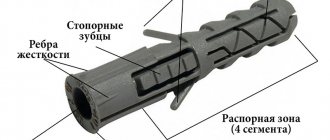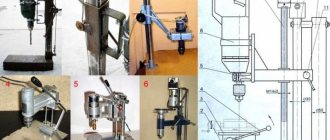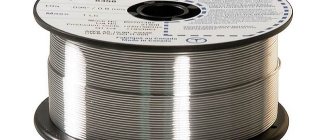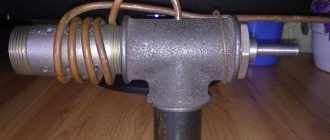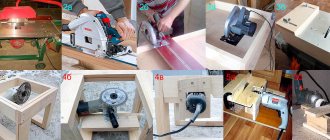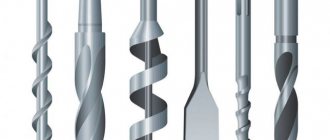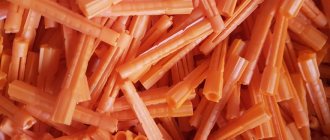Materials characterized by a dense structure and high hardness, which include concrete, brick, natural and artificial stone, are actively used not only in the construction industry, but also in repair work. That is why the question of which dowels to choose for concrete and other solid materials in order to securely fasten various objects to building structures is very relevant.
Anchoring in hollow ceramic blocks requires the use of extended fasteners
The fastening element, which will be constantly under load during operation, must be correctly selected not only in its dimensions, but also in other parameters. Only in this case will it be able to ensure high reliability and durability of the formed connection.
General purpose expansion dowels
This is one of the widest groups of dowels that are used when installing furniture elements, suspended ceilings and other structures to the wall. As the name implies, fixation is carried out by expanding in the material, which means the wall must be quite dense.
Previously, instead of such dowels, wooden choppers were used. They were inserted into the drilled holes and self-tapping screws were screwed in, due to which the assembly was pulled apart and fixed. But it takes a long time to plan a chop from wood each time, so we developed expanding structures with standard dimensions for the diameter of the drills.
Description and principle of operation
For fixation, dowels of this type have moving parts that protrude outward as the screw is screwed in. The dowel itself is made of polyethylene, nylon or polypropylene. These are soft materials that are easily exposed to metal screws from the inside.
The length of the dowels can be extended, shortened or standard. There can be two, three or even four spacer blades. Some designs include a countersunk head to hide subsequent fasteners.
Expansion dowel device.
The “antennae” on the “body” of the element prevents the dowel from turning in the wall when the screw is tightened (due to a drill of the same diameter, the hole is slightly broken and without the “antennae” the plastic insert would easily rotate). The edge at the end prevents the dowel from being pushed deep into the wall.
Elements for fastening are available in standard diameters of 5, 6, 8, 10, 12,14,16 mm.
There are rare sizes of 4, 7 and 20 mm.
Difference in design
All expansion dowels have a split part, which diverges as the hardware is wrapped. The non-spacer base ensures that the integrity of the plastic structure is maintained. There may be a lip at the end to limit the insertion depth, but there are versions without it.
Expansion dowel in the wall.
All dowels in the group are also equipped with a guide cone, which ensures easier entry into the hole. According to the elements of tangential and anchor fixation, they differ into several types.
Expansion dowel with spikes
Installers call this model “chapai”. The design has serrated edges on both sides that release the fasteners in the hole. Two large spikes prevent turning until the teeth are engaged. This design is especially convenient when screwing hardware into the ceiling, when they can fall out under their own weight.
Expansion dowel with spikes.
Expansion reinforced dowel
It is most often called the “hedgehog dowel” because it has small protrusions on four sides that resemble spines. There are no long “antennae” in the design. Unlike the previous one, it expands along its entire length and is great for concrete. Due to fixation in all directions, the fastener can withstand increased loads well.
Expansion reinforced dowel.
Three-spread dowel
The model is designated as T-dowel. The spacer part contains, instead of teeth, solid, even ribs that reliably fix the fastener in the hole. The non-expandable base is equipped with conical projections that prevent the dowel from sinking into the wall. It is often used on brick and concrete to fix shelves, lamps, and paintings.
Three-spread dowel.
Application
In general, the expansion group of dowels perfectly resists shear loads, so the fasteners are optimal for walls. The weights hung on it press down, and the spacer part reliably holds the weight of up to 20-30 kg at each point. Dowels of this type are also suitable for floor installation, for example, to secure the linoleum threshold in a concrete floor. The impact from the legs is across the location of the screw axis and it does not become loose.
But when applying longitudinal force, for example, for attaching objects to the ceiling, they are not the best, since they are less resistant to pulling out. On ceilings and consoles, it is permissible to fix only light interior parts or technical devices (installation of wiring under a suspended decorative ceiling, fastening a lamp, etc.). The fixative holds well in concrete, stone, and brick.
Typical sizes
Let us present the main characteristics of universal products in the form of a table:
| Type | Dimensions | Installation | Permissible load (brick, concrete) | ||||||
| d | L | t | d | h1 | Nbet. | Vbet. | Nbrick. | Vbrick. | |
| Expandet Nail Anchor | Ext. anchor diameter, mm | Anchor length, mm | Max. thickness of fixing item, mm | Diameter dia. holes, mm | Min. height depth holes, mm | Tensile load, kg | Cross-river load, kg | Tensile load, kg | Cross-river load, kg |
| 5×30 | 5 | 30 | 5 | 5 | 40 | 30,59 | 35,69 | 20,39 | 35,69 |
| 5×40 | 5 | 40 | 15 | 5 | 50 | 30,59 | 35,69 | 20,39 | 35,69 |
| 5×50 | 5 | 50 | 25 | 5 | 60 | 30,59 | 35,69 | 20,39 | 35,69 |
| 6×35 | 6 | 35 | 5 | 6 | 45 | 45,88 | 56,08 | 30,59 | 56,08 |
| 6×40 | 6 | 40 | 10 | 6 | 50 | 45,88 | 56,08 | 30,59 | 56,08 |
| 6×50 | 6 | 50 | 20 | 6 | 60 | 45,88 | 56,08 | 30,59 | 56,08 |
| 6×60 | 6 | 60 | 30 | 6 | 70 | 45,88 | 56,08 | 30,59 | 56,08 |
| 6×70 | 6 | 70 | 40 | 6 | 80 | 45,88 | 35,69 | 30,59 | 35,69 |
| 8×50 | 8 | 50 | 10 | 8 | 60 | 56,08 | 91,77 | 45,88 | 91,77 |
| 8×60 | 8 | 60 | 20 | 8 | 70 | 56,08 | 91,77 | 45,88 | 91,77 |
| 8×80 | 8 | 80 | 40 | 8 | 90 | 56,08 | 91,77 | 45,88 | 91,77 |
| 8×100 | 8 | 100 | 60 | 8 | 110 | 56,08 | 50,98 | 45,88 | 50,98 |
| 8×120 | 8 | 120 | 80 | 8 | 130 | 56,08 | 50,98 | 45,88 | 50,98 |
| 8×140 | 8 | 140 | 100 | 8 | 150 | 56,08 | 50,98 | 45,88 | 50,98 |
| 10×80 | 10 | 80 | 30 | 10 | 90 | 76,47 | 50,98 | 56,08 | 50,98 |
| 10×100 | 10 | 100 | 50 | 10 | 110 | 76,47 | 50,98 | 56,08 | 50,98 |
| 10×120 | 10 | 120 | 70 | 10 | 130 | 76,47 | 50,98 | 56,08 | 50,98 |
| 10×140 | 10 | 140 | 90 | 10 | 150 | 76,47 | 50,98 | 56,08 | 50,98 |
| 10×160 | 10 | 160 | 110 | 10 | 170 | 76,47 | 50,98 | 56,08 | 50,98 |
Table 1.
Here the lateral load is the weight that the dowel can support. This is a force directed vertically. That is, from the center of the edge of the fastener to the ground.
Sometimes it is useful to know how many kilograms there will be in 1000 pieces of fasteners. Especially if there is a lot of work to be done and the size of the warehouse is limited.
| Type | Weight 1000 pcs., kg |
| With polypropylene dowel | |
| 6×40 | 3,3 |
| 6×60 | 4,89 |
| 6×80 | 7,28 |
| 8×60 | 8,5 |
| 8×80 | 11,02 |
| 8×100 | 13,78 |
| 8×120 | 16,53 |
| 8×140 | 19,3 |
| 10×100 | 15,32 |
| Gun nails | |
| 4,5×30 | 5,1 |
| 4,5×40 | 6,45 |
| 4,5×60 | 7,7 |
| 4,5×60 | 8,84 |
table 2.
Universal multi-sided dowels
Universal dowels are suitable for installation in different materials by density. The hardness of the base affects the method of attachment.
Description and principle of operation
The dowel design has a spacer part, but it does not just expand slightly, but is capable of folding in the area of the opposite end. Thanks to this, a counter stop is created that reliably holds the fastener and the piece of furniture hung on it.
The holding method depends on the density of the wall material. If the wall is solid, then the expanding part moves apart until it stops and is held in place by friction forces. With a hollow wall, the base goes right through, and due to the deformation of the second edge (bent at an angle of 90 degrees or tied in a knot), an anchor is formed.
Difference in design
There are two types of universal dowel configurations - folding and twisting. The first attracts the plastic strips as the metal pin is screwed in. This creates a persistent crossbar that prevents the fasteners from coming out or knocking out part of the wall.
Multi-sided wall plug.
Folding multi-sided dowel.
The second one has a plastic insert that is screwed into a knot when the threaded element rotates. This leads to the formation of a large seal on the reverse side, preventing the movement of the screw. The first type of dowel can be unscrewed back if desired, but the second type cannot.
Twistable dowel in the wall.
Twistable dowel.
Application
Universal dowels are applicable everywhere where expansion dowels are used. Moreover, they will be able to catch where spacers would simply jump out (for example, in hollow materials). Due to the formation of a large stop on the reverse side, universal dowels adhere better to the ceiling. But they are inferior in terms of load-bearing capacity, and it is undesirable to hang heavy hanging tables, cabinets and other objects on them.
Most often they are used for fixation:
- wooden blocks;
- metal slats;
- parts from suspended ceilings;
Types of dowels for drywall and other thin-walled materials
Thin-walled materials include: gypsum fiber boards, particle boards, plasterboard sheets and others. A regular expansion dowel cannot be fully secured in them due to the low density of the base and shallow depth.
Such panels are often used for decorative wall cladding, insulation or installation of partitions. To hang a picture or shelf on such a base, you can use universal fasteners. But it is better to resort to a variety of dowels designed specifically for thin-walled materials.
The most common are “butterflies” with different design variations, available from many manufacturers. The transformable part can be made of either plastic or metal. The general principle of operation of the dowel is to form a massive stop on the reverse side, due to which the element is securely held in the wall.
For this:
- the thin wall base is passed through with a drill;
- insert the dowel;
- tighten the self-tapping screw.
As it deepens, the thread tightens the far end, expanding the edges of the supporting crossbar.
Other versions of drywall anchors have a one-piece design and are held in place by tall threads. Some can be unscrewed if necessary and installed in a new location, others can be mounted only once and forever.
According to the characteristics, dowels in this category are divided according to wall thickness, but most often they are produced in one size. Then the latch on the reverse side can move completely or partially.
Another parameter is the diameter of the dowel with a “shirt”. The choice of drill for making a hole depends on it. There are types of dowels that can be installed without pre-drilling, which increases productivity. Let's look at each type in more detail.
Dowel butterfly
The fastener was named because of its similarity in shape to butterfly wings. It consists of two parts - a metal screw and a plastic “shirt”. The latter is made of nylon and contains a non-expanding part with a side and a counter end with a thread. Between them there is a folding part, which is additionally reinforced with sliding partitions.
Butterfly dowel.
As the screw is screwed in, the ends are attracted to each other, and the longitudinal ribs become perpendicular, forming a large stop on the reverse side.
Butterfly dowel in a plasterboard wall.
In order for the plastic part to open, the length of the screw must be at least 55 mm. Only in this case will the plastic part open completely. The dowel can be unscrewed and re-tightened. Reliability of retention is not lost in this case.
Use it to attach to drywall:
- cornices;
- chandeliers;
- slats;
- shelves;
- antennas.
Dowel Driva
This is a type of dowel without a flared part. It consists of two elements installed in series. The first is a cone with a helical thread. It can be made of plastic or metal.
Wood dowel made of plastic.
Metal dowel.
The part is inserted into a pre-prepared hole by screwing it in with a special attachment. There are versions with a drill at the end, thanks to which installation occurs without pre-drilling.
Driva dowel with drill.
Due to the high thread turns with a wide pitch, reliable fixation is achieved in the hollow material. A slight protrusion of the element onto the opposite side of the panel is allowed.
Wood dowel in the wall.
The second part of the dowel is a steel self-tapping screw that is screwed into an already installed base. With its help, paintings, frames and other not very heavy objects are attached. The dowel is easy to dismantle if you need to remove the installed elements. When both parts of the dowel are metal, it can even be screwed into chipboards, which have a higher density compared to plasterboard.
Dowel Molly
The most reliable type of drywall dowels is “Molly”. It is made only of metal. This is galvanized steel, which has excellent corrosion resistance, so the fasteners do not deteriorate even in damp rooms. The dowel has a hollow collet with a supporting edge. It has teeth that protect the fasteners from turning. Such fasteners are classified by diameter and length, which is important to consider when choosing a specific thickness of plasterboard sheet.
Dowel Molly.
Installation is carried out using a drill, and then:
- A hollow collet is inserted into the prepared hole.
- Using a special gun, it is pushed apart using a lever method from the reverse side.
- The tool is removed and a screw is inserted into the hole with a metal edge. It just screws on the thread.
If necessary, the screw can be easily unscrewed and reinstalled. The load-bearing capacity is not lost.
Molly dowel in the wall.
One Molly dowel can withstand a load of up to 25 kg, so they are actively used for hanging kitchen furniture, chandeliers, lamps, cornices and shelves.
The screws in Molly dowels come with a countersunk head (so as not to interfere with the installation of other overlapping panels) or with a spherical head (when the mounting eyes are located on top of the furniture or inside the cabinet).
Installation type
There are two ways to install the fastener:
Manual . You will need a hammer drill, screwdriver or hammer. You will have to drill a hole, insert a sleeve into it with your own hands, and then screw or drive in the rod.
Automatic . Installation is carried out using a gun. Use a special nail without a dowel with a strength of 53-56 HRC on the Rockwell scale.
The second option benefits from high installation speed. But the first is good because the standard rod can be pulled out without damaging the material or design.
Dowels for aerated concrete and other porous materials
Aerated concrete, unlike drywall, is voluminous and thick, but contains many voids within its structure. Multiple engagement points are required for secure fixation. Here are the main types of dowels suitable for such material.
Dowel with cutters
The sleeve is made of sheet iron. The working surface has four expanding edges, covered along the entire “body” with cutters. When screwing in the self-tapping screw, the steel teeth seem to “bite” into the aerated concrete and prevent the fastener from moving outward.
Dowel for aerated concrete with cutters.
For reliable installation, it is necessary to correctly select the diameter of the drill so that the dowel does not dangle in it. In this case, the four working edges with cutters will prevent rotation along the axis and will reliably open up. But the product cannot be dismantled, since the metal takes on an expanded shape and does not move back, which means the installation location must be carefully verified.
Dowel for aerated concrete with cutters in the wall.
Dowel with screw ribs
The model is marked GB. It is a plastic conical tube with a cut and solid ribs protruding along the entire structure. They are located with a slight overlap in the spiral, so they rotate slightly at the moment of driving. Due to the long, rounded ribs, the load is evenly distributed over the entire circumference and the dowel sits securely in the aerated concrete wall.
Dowel with screw ribs.
The plastic sleeve can accommodate screws with a diameter of up to 28 mm. Such elements have approval from the German building supervision organization and are suitable for preliminary or permanent installation in aerated concrete.
Dowel with screw ribs.
The length of the screw is calculated by adding the length of the dowel itself, the thickness of the mounting eye and another diameter of the screw. The element is even suitable for fixing into unplastered walls. When installing, it is important to use the drilling mode without impact, otherwise the hole will be too loose and weaken the fixation.
Metal dowel with internal thread
The dowel is made of metal and has high turns of external thread. Due to this structure, it is well retained in the porous material and resists not only shear loads, but also longitudinal effects.
Metal dowel with internal thread.
Installed in a pre-drilled hole using a hex wrench using the rotation method. For large volumes of mounting elements, it is advisable to use a screwdriver or drill at low speeds.
The dowel has proven to be resistant not only to static but also to variable loads, for example, holding shelves, shoe stands, and kitchen hanging cabinets. Since the part is entirely made of metal, it provides increased fire resistance and can be used near heating sources (it is allowed to hang heating radiators or fireplace protective screens on such dowels).
Based on the base materials, the dowel is suitable for:
- solid and hollow light expanded clay;
- solid porous concrete;
- ordinary expanded clay.
Selection rule
This rule is simple and sounds like this: the diameter of the drill is equal to the diameter of the dowel. Relative to its length, it is 3–5 mm longer than the fastening element. This ratio will be optimal. All instruments are marked accordingly. If you want to measure manually - with a caliper, for example - remember that you need to measure the soldering from pobedit, the tool itself is narrower.
Read also: Snowmobile made from a walk-behind tractor for fishing fun
Why do we take a drill longer than the fastener? It's simple - we leave space for dust and crumbs formed during drilling. You also need the screw or self-tapping screw to go beyond the dowel. Then the grip will be maximum and your skill will be at its highest level.
In the video you can see how to insert the fastener into the wall and remove the dust generated during the work.
Frame dowels (facade)
This is the most heavily loaded type of fastener with plastic elements. The model should not be confused with frame anchors, where the “shirt” is also made of metal. The frame dowel uses a plastic sleeve of complex shape and a screw of increased thickness. This allows you to hang particularly heavy parts on the fasteners, eliminating gradual subsidence in the material.
Description and principle of operation
Frame dowels have “whiskers”, teeth and moving parts that stick out to the sides as the screw is turned. The steel element is equipped with a low-profile thread and is produced 10 mm longer than the plastic counterpart. The screw is tightened with a screwdriver, screwdriver, star wrench, and in the largest versions of the dowel, with a spanner.
The model is available in different lengths up to 100 mm, so it is well fixed in numerous places, even when installed in “weak” materials with pores or technical voids. The product is suitable for through installation. The increased dimensions of the fasteners contribute to an increase in the fixation area.
Difference
According to their configuration, frame dowels are conventionally divided by the number of spacer zones. There are one or several such rising plates. The plastic sleeve has comb tracks or single triangular ribs. An expansion zone is provided both next to the cone and closer to the base, which prevents the dowel from loosening in a fragile material with voids.
Application
Due to the design with an increased cross-section of plastic and metal, as well as a more elongated non-expanding part, the frame dowel is suitable for fixing heavy building materials. It is used during installation:
- wooden beams and slats;
- door frames;
- window frames;
- large-diameter communications (for example, sewer pipes);
- brackets and tires;
- façade laths.
The steel element sits securely in the plastic part and resists shearing or bending forces. Since the fasteners provide for through installation, the product always has a collar that protects it from falling into hollow materials. The head can be either hidden for inserting the screw flush or protruding.
Technical characteristics of the fastener
Most construction and finishing works cannot be done without the use of this part. It should also be noted that the dowel-nail is always supplied exclusively as a set, so you don’t have to look for and purchase a separate “frame” for the nail.
We would like to inform you that under no circumstances should screws replace nails; this replacement will be inappropriate, incorrect and impractical. A 6x40 mm dowel-nail, the characteristics of which are its advantages in comparison with similar types of fasteners, can be made of different materials (nylon, polypropylene, polyethylene).
The fastener in question consists of several parts, directly from a dowel (hence the name of this type of nail), double-spacer, on the surface of which there are no tangential fixing elements in the form of ailerons, or, for example, mustaches. The top of the part (later the head) can be of several shapes - cylinder, mushroom-shaped and secretive.
The second element of the 6x40 mm dowel-nail is, directly, a nail in the form of a screw. It is usually made of carbon steel, but this is not the only layer that is used to cover the screw. Among other things, a zinc layer is applied to the surface of the fastening element in question, which serves both for protection and performs a decorative function.
Disc-shaped dowels (fungi, umbrellas)
These are special-purpose dowels with an enlarged plate-shaped head. It increases the clamping area of the fixed material. The diameter of the fungus is possible from 45 to 90 mm. The cross-section of the nail itself is 8 and 10 mm. From the outside, the fasteners are usually covered with finishing materials, such as plaster, and therefore do not affect the design of the building.
Description and principle of operation
The dowel consists of a large plate that distributes the load from the received material more evenly. Since it is used to fix fragile insulation (foam plastic, mineral wool, etc.), the large area of the cap prevents it from breaking through. Installation of fasteners is carried out using a hammer drill, which makes a hole in the wall. Then insulation is applied and a dowel-fungus is inserted through it.
Disc-shaped dowel in the wall.
Fixation is achieved by driving a long nail that pushes the plastic sleeve apart. In this case, it is important not to drill the hole for the dowel very deeply, otherwise there will be a depression on the surface of the insulation. An umbrella on a leg perfectly holds soft material, preventing both displacement along the wall and detachment from it.
Difference
Umbrella dowels are available with or without expansion washers. This additional element fixes the insulation even more reliably.
Disc-shaped dowel with expansion washer.
In addition to wall dowels, they produce fungi for installing roofing materials. In this case, the nail is driven into the concrete (ceiling) and can hold corrugated sheets, ondulin, roofing felt and other sheet panels.
The large cap prevents water from flowing into the mounting hole. With this type of dowel, the plastic umbrella contains three large spikes that prevent movement. The conical part makes it easier to insert the plastic sleeve into a pre-prepared hole.
Dowels for insulation are divided into the following types:
1. With a plastic nail. There are no metal elements in this design. Plastic perfectly tolerates temperature changes from -40 to +80 degrees. The fastener can withstand impacts of 20-380 kg/m². Plastic retains heat transfer better, which is beneficial when installing insulation.
Due to their low cost, most buyers prefer these dowels, but they are not suitable for fixing thick insulation.
Dowel with plastic nail.
2. With a metal nail. A similar design, only the expansion nail is made of galvanized steel. The holder does not rust and can withstand loads of up to 750 kg/m². This is a more reliable way to connect soft insulation and the wall, but cold also passes through the metal. The cost of dowels with steel nails is higher.
Dowel with metal nail.
3. With thermal head. The metal nail head is complemented by a plastic tip. It serves as an insulator and slows down heat transfer. With such a thermal head, the dowels are the most expensive, but the best in quality.
Dowel with a nail with a thermal head.
Application
Umbrella dowels are optimal for fixing mineral wool slabs to walls with subsequent covering with decorative panels. They are used when attaching strips of sheet insulation. They have proven themselves to be good at holding foam boards with a thickness of 25-50 mm. Subsequent plastering completely aligns the attachment points with the general surface and hides them.
We take into account what we will attach
Some building materials and structures cannot be fastened with conventional dowels. They require special, highly specialized fasteners, otherwise all the work may go down the drain. Let's look at such examples.
Thermal insulation and waterproofing
The most common option is a mushroom dowel (plate-shaped). Its large head allows you to attach polystyrene, polystyrene and other similar materials as firmly as possible and at the same time accurately.
Types of dowels based on material of manufacture
Although there are dowels with metal sleeves, most often this type of fastener is made of plastic. It is more affordable and does not require complex equipment with high heating temperatures to melt and give the desired shape. There are three types of plastic available.
Polyethylene (PE)
It is a product obtained by the polymerization of colorless ethylene gas. During the crystallization process, a dense plastic mass is formed. The structural formula of polyethylene belongs to saturated hydrocarbons and contains (-CH2-CG2-)n.
The substance tolerates exposure to negative temperatures down to -40 degrees. The plastic is quite durable, has high viscosity and does not absorb water. The material does not dissolve under the influence of gasoline, oils, acids, alkalis and alcohols.
Disadvantages include susceptibility to aging, a tendency to crack at too low temperatures, and destruction from aromatic hydrocarbons, as well as chlorinated hydrocarbons.
Polyethylene dowel.
Polypropylene (PP)
It is a derivative of ethylene. The structural formula classifies it as a saturated hydrocarbon and looks like this: (-CH2-CH(CH3)-)n. The material serves well at elevated temperatures up to +80 degrees, but is not so good in cold weather. Susceptible to aging and cracking. Under normal conditions, it is not brittle and hard, and does not absorb water at all.
Polypropylene can withstand prolonged contact with acids, alkalis, alcohols and saline solutions, but it also deteriorates from chlorinated hydrocarbons. This substance also allows odors to pass through.
Polypropylene dowel.
